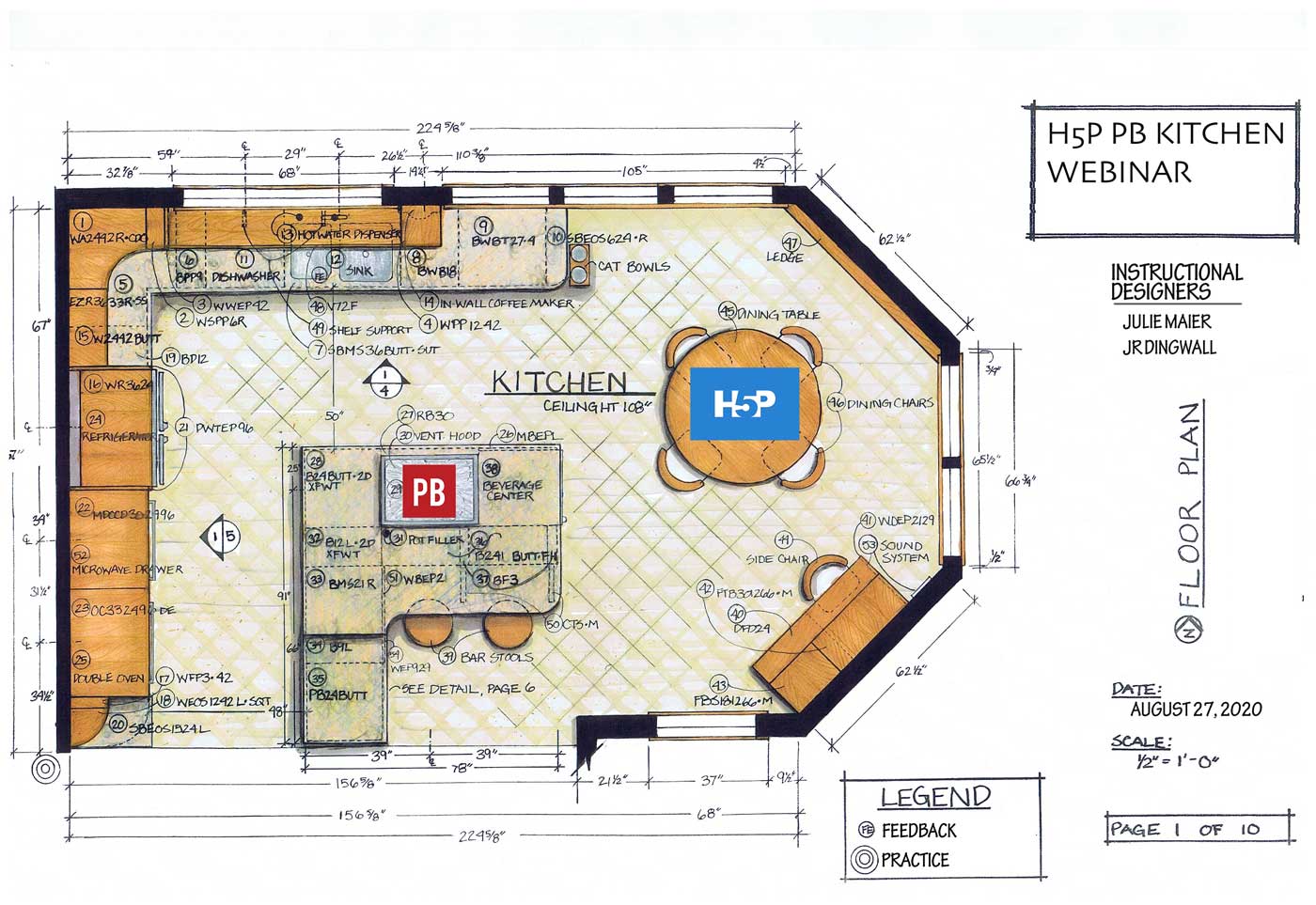The second “Cooking Show” aka webinar for this project was on August 27 at 9:00am Pacific Time. This show is being run as an open BCcampus webinar, so we expect a wider audience of interested colleagues.
The archive of this session is now available:
Our format still remains friendly and conversational. This month’s topic is focused on the design of “good” practice problems.
As cooking is more than just tossing ingredients into a pot to simmer, the development of effective open textbooks problems calls for the methodology and approaches of instructional designers.
In this month’s webinar, we welcome two colleagues from the University of Saskatchewan’s Distance Education Unit.
Both JR Dingwall and Julie Maier bring in instructional design knowledge and experience in integrating H5P activities into open textbooks. They will share some examples of their own kitchen work as well as some feedback from students who have used these resources.
We will engage them in conversations about what makes a good practice exercise, including:
- What are important design elements for creating practice problems in open textbooks?
- What considerations go into choosing the H5P content types?
- What advice, suggestions do they provide when working with faculty for designing practice problems?
- How do they create/design useful feedback?
We ask you also to bring in your own “dishes”- bring your H5P practice problems you are currently working on to get feedback from our guests and other project participants.
Guests in the Kitchen

Julie Maier (M.Ed, Educational Technology & Design) is an Instructional Designer at the University of Saskatchewan’s Distance Education Unit, where she works in course- and program-level design and development for online and blended learning. She has worked on a number of Pressbooks publications via USask Open Press, including adaptations, remixes, ports, and new books from scratch. She has collaborated with instructors to incorporate H5P activities into course materials in WordPress, Blackboard, Canvas, and Pressbooks, and continues to look for new and authentic ways in which H5P might be used to engage students and facilitate learning in distributed settings.
Follow Julie on twitter @juliejeremiah.

JR Dingwall is an instructional designer based in the Distance Education Unit at the University of Saskatchewan, Saskatoon. He designs and develops instruction for a variety of delivery formats (face-to-face, blended, and online) in post-secondary, not-for-profit, continuing education, and open education contexts. JR began experimenting with H5P and Pressbooks in 2016 for use in professional learning settings, and since then he has integrated them into his wider professional practice. JR is an educator at heart, holding a B.Ed (Practical and Applied Arts) and M.Ed (Educational Technology and Design), and uses these two edtech tools to increase accessibility to course materials, promote effective teaching and learning strategies, and enhance students’ learning experiences in online courses.
Find out more at http://jrdingwall.ca and follow JR on twitter @JRDingwall. See also some recent blog posts by JR on his related work:
- H5P and Pressbooks, a Brief Highlight Reel
- Which H5P Type is Right for You?
- Designing Useful Feedback in H5P
- The DOER Effect and H5P
Links and Links
See the link packed document of demos and examples shared by Julie and JR. It’s like a bag of gold. We appreciate how they organized things around the design scaffolding approach and the DOER effect.
Other links mentioned in chat:
- 9x9x25 Blogging Challenge https://9x9x25.wordpress.com/
- Subscribe to BCcampus Newsletter: https://bccampus.ca/subscribe/
- OER hub in development from H5P https://h5p.org/oer-hub-coming
- “doer effect” https://opencontent.org/blog/archives/6001
- Design document that we have made available to our H5P grantees, based on work from Lumen Learning around designing H5P activities and the DOER effect (this is a Word document) https://kitchen.opened.ca/wp-content/uploads/sites/1504/2020/07/Design-Scaffold-for-Creating-an-Online-Interactive-Practice-Activity.docx
- H5P Interactive Book type https://h5p.org/content-types/interactive-book
- H5P includes close to 50 different interactive activities https://h5p.org/content-types-and-applications
- Blooms Taxonomy in H5P https://h5pstudio.ecampusontario.ca/content/2904
- Dental chart drag and drop activity, because it works with things that would be done in practice https://h5pstudio.ecampusontario.ca/content/3704
- I’ve found this infographic to be helpful when working with instructors: https://www.kpu.ca/teaching-and-learning/technology/h5p
And mentioned later in twitter:
Additional Resources
See also in the H5P/PB Kitchen:
- Design Scaffold for Creating an Online Interactive Practice Activity “Based on a version created by Lumen Learning, this worksheet guides creating the kind of activities that achieve the “doer” effect. This is grounded in research that shows a six-fold increase on learning over reading or viewing content.” Available as a Word document or a copyable Google Doc.
- Writing Good Multiple Choice Questions. A resource from the Vanderbilt University Center for Teaching, with examples here converted to H5P items.
- Getting Started in H5P. Since we see much general interest in H5P for this webinar, here are our recommended places to start if you are just learning about it.
Questions (and some answers) From Chat
- How would you suggest instructors modify interactive H5P exercises for students who need print versions of books (or have other accessibility requirements)? Especially if these assessments are critical to understanding a certain topic or concept.
- Where do folks park all these H5Ps that are being used in Pressbooks?
- Is it possible to move the interactive components from the end of the chapter to say the end of a section within the chapter?
- I wonder if you know any important difference using h5p and any other HTML5 tools in Open Text like in Pressbook.
- Does H5P have flash cards and accordion and summary builder?
- Yes. H5P includes close to 50 different interactive activities. You can see a summary at https://h5p.org/content-types-and-applications
- Can you overkill H5P content?
- I’ve been thinking about that. I’m making some interactive videos. One that I am working on has 5 questions in a 5 minute video. I can imagine it getting overwhelming and a little stunted if there are too many questions in the video
- That is a good question. I don’t know of any empirical research that has been done on how much is the sweet spot, but my gut says yes.
- I think it really comes down to the learning objectives: I managed to make one H5P that serves as welcome package for my fall course and it’s so much better than multiple webpages, videos and links.
- But there is a lot of variety in H5P in terms of activity types so I imagine having a variety of different interactions can help
- So, are you saying you can embed H5P content within H5P content?
- There are some content types that have the ability to include elements like multiple choice, matching, drag and drop. See the latter part of this post that talks about different ways to look at the tools https://kitchen.opened.ca/2020/06/19/organizing-h5p/
- Where would you find H5P resources?
- the best place is http://h5p.org
- I am keen on using H5P for another course. It is not currently available on Canvas or our Uni’s wordpress. Do you have any tips for where I can get it (apart from h5p.org) that I can develop content and then iframe it into Canvas?
- try ecampusontario H5P studio https://h5pstudio.ecampusontario.ca/
- If one has some H5P content in a particular repository, is it wise to port them into other repositories?
- the new H5P hub will be a big answer, it will be built into the H5P tool when it is published
- When the global h5p repository makes it’s appearance, it will be based on a design of keeping it locally and sharing a synced, tagged copy to the global repository, where anyone can then download and sync w/ their own.
- Has anyone ever tried student H5P creation as a learning activity?
And one more appreciated shout out to JR Dingwall for another post-show blog post with answers to some of these questions. See August Webinar Wrap Up – ID of Practice Problems in Pressbooks with H5P.
This event is free. To ensure we have an inclusive and welcoming environment for all, we’ve added registration to our webinars. Please note that it will close two hours before the event.
This notice is to inform you that this session will be recorded, archived, and made available publicly on BCcampus.ca. By participating in this session, you acknowledge that your participation in this session will be recorded and the recording will be made available openly.
Image Credit: Foster Kitchen Design-Floor Plan flickr photo by therichardlife shared under a Creative Commons (BY-SA) license modified by Alan Levine with H5P and Pressbooks logo and text specific to this event.


